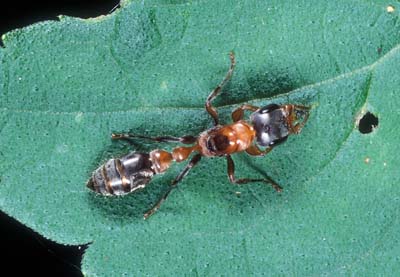
Adult elongate twig ant, Pseudomyrmex gracilis.
(Photographer: Lyle Buss, University of Florida)
Ants sometimes are confused with termites but can be distinguished by their distinctly elbowed antennae and the narrow constriction ("waist") between the thorax and abdomen. Ants lack wings, except for the reproductive castes (males and queens) which only have wings during periods of mating and dispersal. Most species are brown or black, and range in size from 1 to 20 mm. The first, or first and second, segments of the abdomen appear like humps or nodes.
All ants are social insects with three distinct castes- males (drones) and females (queens and workers). The female queens are larger than the male drones and female workers. After mating and shedding her wings, the queen starts a colony by laying eggs in galleries and producing a cohort of workers, which are sterile females. The males die soon after mating but the queens may live for several years. Once the first workers are produced, they take over the work of the colony, and the queen does little more than lay eggs. Nests are constructed in plant cavities, wood, in the ground, and many other places. The colonies can vary greatly in size, even within a species.
Ants are the most abundant predators in some natural areas, where they impact the population dynamics of other invertebrates and organisms. They were the first group of insects used to control citrus pests in southern China, and this practice continued for at least 1,700 years. Some research in the U.S. has shown that the red imported fire ant (otherwise a troublesome, invasive pest) is an effective predator of other pests and may even increase production in some vegetable fields, but this is greatly dependent upon the presence or absence of the types or species of other vegetable pest species.
Approximately 600 species of ants occur in Canada and the US.
Images
To save the Web-optimized images shown below to your hard drive:
|
Click to access Display and Print quality images. |
|
Click to access Display and Print quality images. |